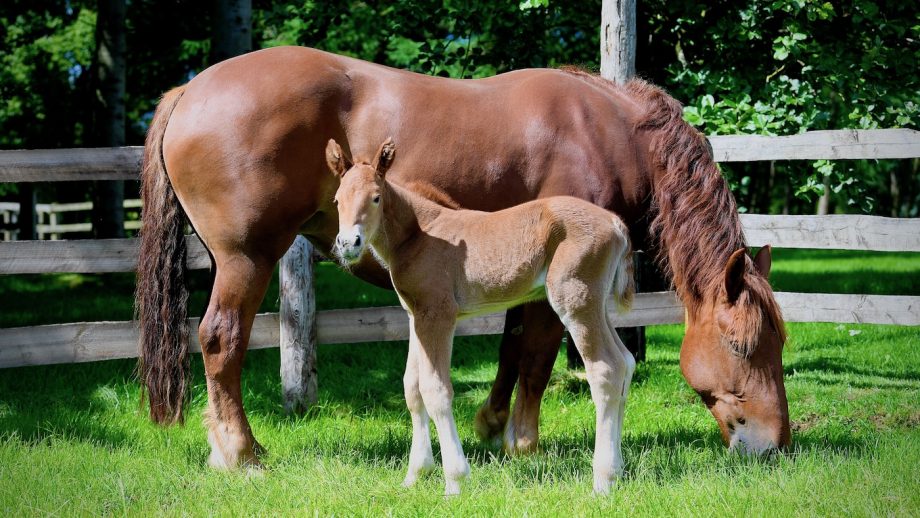This is not fake news, experts have warned: our rare native breeds will disappear before our eyes if we do not act now. H&H hears what measures are being taken and how science can help save our equine heritage
WE have to act now, if we want to save our equine heritage – and we have a range of scientific weapons in the fight for our rare breeds.
This was the topic of discussion at the first of two webinars held in advance, and as part of, the 2021 National Equine Forum, on 13 January.
{"content":"PHA+V2l0aCB0aGUgdGl0bGUg4oCcSnVzdCBpbiBUaW1lIOKAkyBVc2luZyBTY2llbmNlIHRvIFNhdmUgb3VyIEJyZWVkc+KAnSwgc3BlYWtlcnMgY292ZXJlZCB0aGUgaXNzdWVzIGZhY2luZyBvdXIgPGEgaHJlZj0iaHR0cHM6Ly93d3cuaG9yc2VhbmRob3VuZC5jby51ay90YWcvcmFyZS1icmVlZHMiPmVuZGFuZ2VyZWQgbmF0aXZlIGhvcnNlcyBhbmQgcG9uaWVzPC9hPiwgYW5kIGhvdyBzY2llbnRpZmljIGFkdmFuY2VzIGFyZSBiZWluZywgYW5kIGNhbiBiZSwgdXNlZCB0byBzZWN1cmUgdGhlaXIgZnV0dXJlLjwvcD4KPHA+4oCcVGhlIG92ZXJhbGwgbWVzc2FnZSBpcyB0aGF0IHRoZXJl4oCZcyBzZXJpb3VzIGNvbmNlcm4sIGJ1dCB0aGVyZSBhcmUgdGhpbmdzIHdlIGNhbiBkbyzigJ0gc2FpZCBUaW0gTW9ycmlzLCB2aWNlLWNoYWlybWFuIG9mIHRoZSBSYXJlIEJyZWVkcyBTdXJ2aXZhbCBUcnVzdCwgYXMgaGUgaW50cm9kdWNlZCB0aGUgc3BlYWtlcnMuPC9wPgo8cD5TdGFsbGlvbiBBSSBTZXJ2aWNlcyBmb3VuZGVyIFR1bGxpcyBNYXRzb24sIHdobyBoYXMgd29ya2VkIGV4dGVuc2l2ZWx5IG9uIHByZXNlcnZpbmcgZW5kYW5nZXJlZCBicmVlZHMgYW5kIHdpbGRsaWZlLCBsb29rZWQgYXQgdGhlIHdpZGVyIGNvbnRleHQgZmlyc3Q7IHRoYXQgdGhlIHdvcmxkIGlzIGZhY2luZyBpdHMgc2l4dGggbWFzcyBleHRpbmN0aW9uLCB3aXRoIGh1bmRyZWRzIG9mIGxhbmQgc3BlY2llcyBhdCByaXNrIG9mIGJlaW5nIGxvc3QuPC9wPgo8cD48ZGl2IGNsYXNzPSJhZC1jb250YWluZXIgYWQtY29udGFpbmVyLS1tb2JpbGUiPjxkaXYgaWQ9InBvc3QtaW5saW5lLTIiIGNsYXNzPSJpcGMtYWR2ZXJ0Ij48L2Rpdj48L2Rpdj48c2VjdGlvbiBpZD0iZW1iZWRfY29kZS0zMSIgY2xhc3M9ImhpZGRlbi1tZCBoaWRkZW4tbGcgcy1jb250YWluZXIgc3RpY2t5LWFuY2hvciBoaWRlLXdpZGdldC10aXRsZSB3aWRnZXRfZW1iZWRfY29kZSBwcmVtaXVtX2lubGluZV8yIj48c2VjdGlvbiBjbGFzcz0icy1jb250YWluZXIgbGlzdGluZy0tc2luZ2xlIGxpc3RpbmctLXNpbmdsZS1zaGFyZXRocm91Z2ggaW1hZ2UtYXNwZWN0LWxhbmRzY2FwZSBkZWZhdWx0IHNoYXJldGhyb3VnaC1hZCBzaGFyZXRocm91Z2gtYWQtaGlkZGVuIj4NCiAgPGRpdiBjbGFzcz0icy1jb250YWluZXJfX2lubmVyIj4NCiAgICA8dWw+DQogICAgICA8bGkgaWQ9Im5hdGl2ZS1jb250ZW50LW1vYmlsZSIgY2xhc3M9Imxpc3RpbmctaXRlbSI+DQogICAgICA8L2xpPg0KICAgIDwvdWw+DQogIDwvZGl2Pg0KPC9zZWN0aW9uPjwvc2VjdGlvbj48L3A+CjxwPuKAnFRoaXMgaXNu4oCZdCBmYWtlIG5ld3Ms4oCdIGhlIHNhaWQuIOKAnEV4dGluY3Rpb24gaXMgbm9ybWFsIGluIGV2b2x1dGlvbiBidXQgd2XigJlyZSBub3cgaW4gZnJlZWZhbGwgYW5kIHdl4oCZcmUgZ29pbmcgdG8gc2VlIGEgbG90IG9mIHNwZWNpZXMgZGlzYXBwZWFyaW5nIGlmIHdlIGRvbuKAmXQgZG8gc29tZXRoaW5nLiBBbmQgaXTigJlzIG5vdCBqdXN0IHdpbGQgYW5kIGV4b3RpYyBzcGVjaWVzOyB0aGlzIGlzIGhhcHBlbmluZyBoZXJlIGluIHRoZSBVSyB3aXRoIG91ciBuYXRpdmUgaG9yc2UgYnJlZWRzLCByaWdodCBpbiBmcm9udCBvZiB1cy48L3A+CjxwPuKAnFRoZXJlIGFyZSAxNCBlcXVpbmUgYnJlZWRzIG5hdGl2ZSB0byB0aGUgVUs7IDEyIGFyZSByYXJlIGFuZCBmaXZlIG9mIHRob3NlIGFyZSBjcml0aWNhbGx5IGVuZGFuZ2VyZWQuIFdlIGhhdmUgdG8gZG8gc29tZXRoaW5nLuKAnTwvcD4KPGgzPkV4dGluY3Rpb24gdm9ydGV4PC9oMz4KPHA+VHVsbGlzIGRpc2N1c3NlZCB0aGUgZXh0aW5jdGlvbiB2b3J0ZXg7IHRoZSBzdGF0ZSBjYXVzZWQgYnkgaW5icmVlZGluZyBhbmQgbGFjayBvZiBnZW5ldGljIGRpdmVyc2l0eSB0aGF0IG1lYW5zIHBvcHVsYXRpb25zIGRlY2xpbmUgdG8gdGhlIHBvaW50IG9mIG5vIHJldHVybi4gVGhpcyBjYW4gYmUgYmVhdGVuIGJ5IHN0cmF0ZWdpYyBicmVlZGluZywg4oCcbGlrZSB0aGUgVGluZGVyIG9mIHRoZSBob3JzZSB3b3JsZOKAnSwgVHVsbGlzIHNhaWQsIHRvIG1hdGNoIG1hcmVzIHdpdGggYXBwcm9wcmlhdGUgc3RhbGxpb25zLjwvcD4KPGRpdiBjbGFzcz0iYWQtY29udGFpbmVyIGFkLWNvbnRhaW5lci0tbW9iaWxlIj48ZGl2IGlkPSJwb3N0LWlubGluZS0zIiBjbGFzcz0iaXBjLWFkdmVydCI+PC9kaXY+PC9kaXY+CjxwPlRoZXJlIGFyZSBtYW55IHdheXMgbm93IG9mIHBlcnNldmVyaW5nIGdlbmV0aWMgbWF0ZXJpYWwsIFR1bGxpcyBzYWlkLiBJZiBjb2x0cyBvciBzdGFsbGlvbnMgd2l0aCBpbXBvcnRhbnQgZ2VuZXMgZGllIG9yIGFyZSBjYXN0cmF0ZWQsIHNlbWVuIGNhbiBiZSBleHRyYWN0ZWQgZnJvbSB0aGUgdGVzdGljbGVzIGFuZCBzdG9yZWQuIEZlbWFsZSBnYW1ldGVzIGNhbiBiZSBleHRyYWN0ZWQgZnJvbSBtYXJlcyBhbmQgc3RvcmVkLCBhbmQsIHVzaW5nIGEgcHJvY2VzcyBjYWxsZWQgaW50cmEtY3l0b3BsYXNtaWMgc3Blcm0gaW5qZWN0aW9uIChJQ1NJKSBhIHNpbmdsZSBzcGVybSBjYW4gYmUgaW5qZWN0ZWQgaW50byB0aGUgZWdnIHRvIGNyZWF0ZSBhbiBlbWJyeW8sIHdoaWNoIGNhbiB0aGVuIGFsc28gYmUgZnJvemVuLjwvcD4KPHA+SGUgYWxzbyBjaXRlZCB0aXNzdWUtYmFua2luZywgcmVmZXJyaW5nIHRvIHRoZSA8YSBocmVmPSJodHRwczovL3d3dy5ob3JzZWFuZGhvdW5kLmNvLnVrL3BsdXMvbmV3cy1wbHVzL2hvdy1hLWNsb25lZC1wcnpld2Fsc2tpcy1mb2FsLWNvdWxkLWhlbHAtc2F2ZS1zcGVjaWVzLWZyb20tZXh0aW5jdGlvbi03MjUwOTciPlByemV3YWxza2nigJlzIGhvcnNlIGNvbHQ8L2E+IGJvcm4gaW4gdGhlIFVTIGxhc3QgeWVhciwgaGF2aW5nIGJlZW4gY2xvbmVkIGZyb20gZ2VuZXRpYyBtYXRlcmlhbCBzdG9yZWQgNDAgeWVhcnMgYmVmb3JlaGFuZC48L3A+CjxkaXYgY2xhc3M9ImFkLWNvbnRhaW5lciBhZC1jb250YWluZXItLW1vYmlsZSI+PGRpdiBpZD0icG9zdC1pbmxpbmUtNCIgY2xhc3M9ImlwYy1hZHZlcnQiPjwvZGl2PjwvZGl2Pgo8cD7igJxUaGlzIHJlYWxseSBjYW4gaGVscCwgYnV0IHdlIG5lZWQgdG8gc3RvcmUgdGhlIG1hdGVyaWFsIG5vdyzigJ0gaGUgc2FpZC4g4oCcV2Ugc3RhbmQgYXQgYSBwaXZvdGFsIHRpbWUgZm9yIHRoZSBzdXJ2aXZhbCBvZiBtYW55IHNwZWNpZXMgYW5kIG91ciByYXJlIGJyZWVkcywgYW5kIHdlIG5lZWQgdG8gZG8gdGhpcyBub3QganVzdCBmb3Igb3VyIGZ1dHVyZSwgYnV0IGZvciBmdXR1cmUgZ2VuZXJhdGlvbnMu4oCdPC9wPgo8cD5XZWF0aGVyYnlzIGdlbmVyYWwgc3R1ZGJvb2sgZGlyZWN0b3IgU2ltb24gQ29vcGVywqBzcG9rZSBhYm91dCBpbmJyZWVkaW5nIGluIHRob3JvdWdoYnJlZHMsIHdobyBhcmUgYWxsIGRlc2NlbmRlZCBmcm9tIHRocmVlIGZvdW5kYXRpb24gc2lyZXMsIGFuZCB3aGF0IGlzIGJlaW5nIGRvbmUgdG8gY29tYmF0IGl0LjwvcD4KPGRpdiBjbGFzcz0iYWQtY29udGFpbmVyIGFkLWNvbnRhaW5lci0tbW9iaWxlIj48ZGl2IGlkPSJwb3N0LWlubGluZS01IiBjbGFzcz0iaXBjLWFkdmVydCI+PC9kaXY+PC9kaXY+CjxwPkhlIHNhaWQgdGhhdCBhcyBicmVlZGluZyBpbiB0aG9yb3VnaGJyZWRzIGlzIGZvciBwZXJmb3JtYW5jZSwgdGhlcmUgaXMgYSDigJxzdXJ2aXZhbCBvZiB0aGUgZml0dGVzdOKAnSBvdXRjb21lLCBhbmQgYWRkZWQgdGhhdCB0aGUgcnVsZSBvZiBuYXR1cmFsIGNvdmVyaW5nIG9ubHkgd2FzIHB1dCBpbiBwbGFjZSB0byBjb21iYXQgaW5icmVlZGluZy48L3A+CjxwPkFuZCBhbHRob3VnaCB0aGUgYnJlZWTigJlzIGluYnJlZWRpbmcgY29lZmZpY2llbnQsIHdoaWNoIG1lYXN1cmVzIHRoZSBkZWdyZWUgb2YgaW5icmVlZGluZywgaXMgbG93ZXIgdGhhbiByYXJlIGJyZWVkcyBzdWNoIGFzIHRoZSBDbHlkZXNkYWxlLCBpdCBpcyBoaWdoZXIgdGhhbiBtb3JlIGNvbW1vbiB0eXBlcyBvZiBob3JzZSDigJMgYW5kIHRoZSBnbG9iYWwgcG9wdWxhdGlvbiBvZiB0aG9yb3VnaGJyZWRzIGlzIGRlY3JlYXNpbmcsIHdpdGggMTIzLDAwMCBmb2FscyBib3JuIDE2IHllYXJzIGFnbyBhbmQgb25seSA4OCwwMDAgaW4gMjAxOCB3aXRoIGEgcmVzdWx0aW5nIGRyb3AgaW4gZ2VuZXRpYyBkaXZlcnNpdHkuPC9wPgo8cD5UaGVyZSBoYXMgYWxzbyBiZWVuIGEgYmlnZ2VyIGRlY3JlYXNlIGluIHRoZSBudW1iZXIgb2Ygc3RhbGxpb25zIHRoYW4gdGhlIG51bWJlciBvZiBtYXJlcywgd2hpY2ggbWVhbnMgbWFsZXMgY292ZXJpbmcgbW9yZSBmZW1hbGVzLCBhbmQgYWdhaW4gbGVzcyBkaXZlcnNpdHkuPC9wPgo8cD5IZSBzYWlkIG1lYXN1cmVzIGFyZSBiZWluZyB0YWtlbiwgc3VjaCBhcyBsZWFkaW5nIGdsb2JhbCBzdHVkYm9vayBhdXRob3JpdGllcyB3b3JraW5nIHRvZ2V0aGVyLCBsaW1pdHMgaW50cm9kdWNlZCBpbiBzb21lIGNvdW50cmllcyB0byB0aGUgbnVtYmVyIG9mIG1hcmVzIGEgc3RhbGxpb24gY2FuIGNvdmVyIGFuZCBnZW5lIGFuYWx5c2lzIHRvIG1vbml0b3IgZGl2ZXJzaXR5LjwvcD4KPHA+4oCcSW4gYWxsIG9mIHRoaXMsIHdoYXQgd2UgbXVzdCBjb25zaWRlciBmaXJzdCBpcyB3aGF04oCZcyBiZXN0IGZvciB0aGUgaG9yc2UgYmVmb3JlIHdoYXTigJlzIGJlc3QgZm9yIHRoZSBpbmR1c3RyeSzigJ0gaGUgc2FpZC48L3A+CjxwPkFuZHkgRGVsbCwgb2YgdGhlIDxhIGhyZWY9Imh0dHBzOi8vd3d3LmhvcnNlYW5kaG91bmQuY28udWsvdGFnL2NsZXZlbGFuZC1iYXkiPkNsZXZlbGFuZCBCYXk8L2E+IEhvcnNlIFNvY2lldHksIHNwb2tlIG9mIHRoZSBTcGFya3MgcHJvZ3JhbW1lLCB3aGljaCBoYXMgYmVlbiBpbiB1c2UgZm9yIDE2IHllYXJzLCBzaW5jZSB0aGUgc29jaWV0eSBkaWdpdGlzZWQgaXRzIHJlY29yZHMgYW5kIHNhdyBhIOKAnGRpc3R1cmJpbmfigJ0gaW5jcmVhc2UgaW4gaW5icmVlZGluZy48L3A+CjxwPlRoZSBzeXN0ZW0gaXMgYmFzZWQgb24gbWFyZS0gYW5kIHN0YWxsaW9uLWJhc2VkIGRhdGEgc2hlZXRzLCB3aGljaCBpbiB0dXJuIGFyZSBiYXNlZCBvbiBnZW5ldGljIGFuYWx5c2lzLiBUaGVzZSBjYWxjdWxhdGUgdGhlIG1lYW4ga2luc2hpcDsgdGhlIHJlbGF0aW9uc2hpcCBiZXR3ZWVuIGFueSBvbmUgYW5pbWFsIGFuZCBhbm90aGVyLCBhbmQgdGhlIHBvdGVudGlhbCBpbmJyZWVkaW5nIGZyb20gYW55IG1hdGluZy4gRWFjaCBtYXRjaCBpcyByYW5rZWQgZnJvbSBncmVlbiwgYSBtYXRpbmcgdG8gYmUgZW5jb3VyYWdlZCwgdG8gcmVkLCB3aGljaCBzaG91bGQgYmUgYXZvaWRlZC48L3A+CjxwPkRyIERlbGwgc2FpZDog4oCcWW91IGNhbuKAmXQgYnJlZWQgYnkgbnVtYmVycyBhbG9uZSBidXQgdGhpcyBpcyBvbmUgdG9vbCBpbiB0aGUgYnJlZWRlcuKAmXMgdG9vbGJveC4gSXQgbGVhdmVzIGJyZWVkZXJzIGluIGNvbnRyb2wsIHRvIG1ha2UgY2hvaWNlcyBnb29kIGZvciB0aGVtc2VsdmVzIGFuZCBnb29kIGZvciB0aGUgYnJlZWQu4oCdPC9wPgo8cD5IZSBhZGRlZCB0aGF0IHNpbmNlIFNwYXJrcyB3YXMgaW50cm9kdWNlZCwgdGhlIGluY3JlYXNlIGluIGluYnJlZWRpbmcgaGFzIHJlZHVjZWQgYWxtb3N0IHRvIHplcm8sIGFuZCB0aGUgcG9wdWxhdGlvbiBvZiBDbGV2ZWxhbmQgQmF5cyBpcyBub3cgZmFyIG1vcmUgdmlhYmxlLjwvcD4KPGRpdiBjbGFzcz0iaW5qZWN0aW9uIj48L2Rpdj4KPHA+4oCcQWx0aG91Z2ggdGhlc2UgYnJlZWRzIGFyZSBlbmRhbmdlcmVkLCB0aGV5IGRvIHN0aWxsIGhhdmUgYSBmdXR1cmUs4oCdIGhlIHNhaWQuPC9wPgo8cD5EciBEZWxsIGFkZGVkIHRoYXQgY2hhbmdlIGlzIGFzIG11Y2ggYWJvdXQgbWFuYWdpbmcgcGVvcGxlIGFzIG1hbmFnaW5nIGhvcnNlcy4gQnJlZWRlcnMgbXVzdCBiZSBicm91Z2h0IG9uIGJvYXJkLCB3aGlsZSBicmVlZCBzb2NpZXRpZXMgc2hvdWxkIGNvbGxlY3QgYW5kIGFuYWx5c2UgZGF0YSB0aGVuIHB1dCBwbGFucyBpbiBwbGFjZSB0byBtYW5hZ2UgYW5kIG1vbml0b3IuPC9wPgo8cD4K"}
You might also be interested in…
Stay in touch with all the news in the run-up to and throughout the major shows and events during 2025 and beyond with a Horse & Hound subscription. Subscribe today for all you need to know ahead of these major events, plus online reports on the action as it happens from our expert team of reporters and in-depth analysis in our special commemorative magazines. Have a subscription already? Set up your unlimited website access now
H&H news editor
Eleanor is an experienced journalist who spent over eight years working for local and national newspapers before joining H&H as news editor in March 2016. Passionate about equine welfare and exposing the truth, Eleanor has reported on all aspects of the industry, from Brexit to anti-bullying campaigns, and from dressage rules to mules. Her sport of choice is showjumping, in which she competes her own horses, and she also enjoys reporting at local jumping shows through to international championships.





